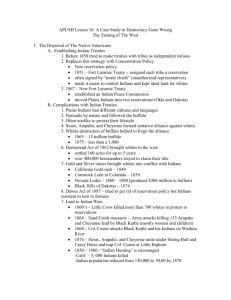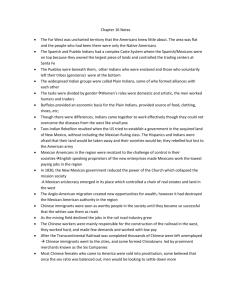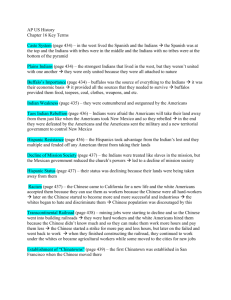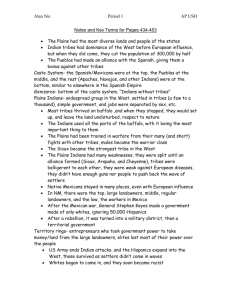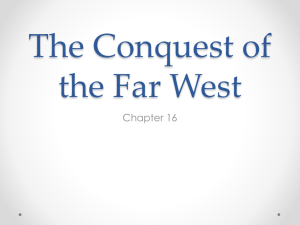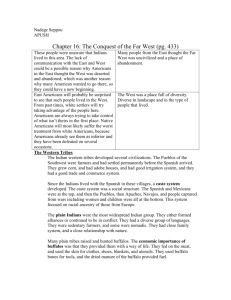Chapter_16_KT - catherinepAPnotebook
advertisement
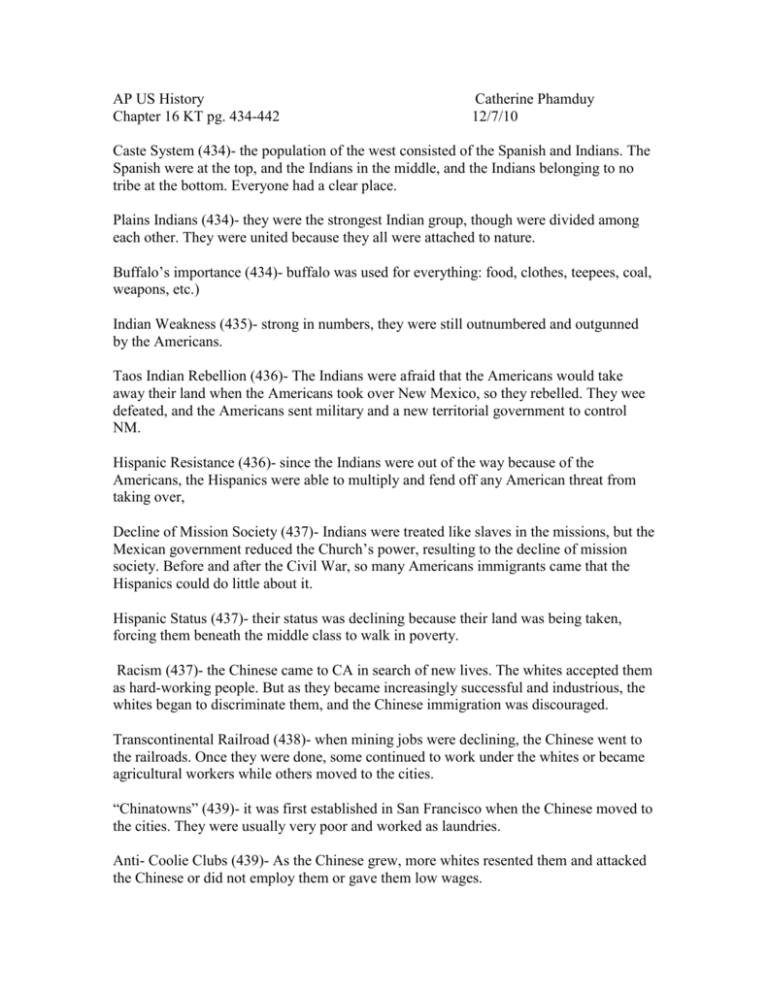
AP US History Chapter 16 KT pg. 434-442 Catherine Phamduy 12/7/10 Caste System (434)- the population of the west consisted of the Spanish and Indians. The Spanish were at the top, and the Indians in the middle, and the Indians belonging to no tribe at the bottom. Everyone had a clear place. Plains Indians (434)- they were the strongest Indian group, though were divided among each other. They were united because they all were attached to nature. Buffalo’s importance (434)- buffalo was used for everything: food, clothes, teepees, coal, weapons, etc.) Indian Weakness (435)- strong in numbers, they were still outnumbered and outgunned by the Americans. Taos Indian Rebellion (436)- The Indians were afraid that the Americans would take away their land when the Americans took over New Mexico, so they rebelled. They wee defeated, and the Americans sent military and a new territorial government to control NM. Hispanic Resistance (436)- since the Indians were out of the way because of the Americans, the Hispanics were able to multiply and fend off any American threat from taking over, Decline of Mission Society (437)- Indians were treated like slaves in the missions, but the Mexican government reduced the Church’s power, resulting to the decline of mission society. Before and after the Civil War, so many Americans immigrants came that the Hispanics could do little about it. Hispanic Status (437)- their status was declining because their land was being taken, forcing them beneath the middle class to walk in poverty. Racism (437)- the Chinese came to CA in search of new lives. The whites accepted them as hard-working people. But as they became increasingly successful and industrious, the whites began to discriminate them, and the Chinese immigration was discouraged. Transcontinental Railroad (438)- when mining jobs were declining, the Chinese went to the railroads. Once they were done, some continued to work under the whites or became agricultural workers while others moved to the cities. “Chinatowns” (439)- it was first established in San Francisco when the Chinese moved to the cities. They were usually very poor and worked as laundries. Anti- Coolie Clubs (439)- As the Chinese grew, more whites resented them and attacked the Chinese or did not employ them or gave them low wages. Chinese Exclusion Act (440)- the Chinese immigration was stopped for 10 years, and it kept the Chinese from becoming citizens. Americans were just afraid that their jobs would be taken and the act became law in 1902. Chinese Resistance (440)- they decided to file a lawsuit and write to the president, but the efforts had no effect. Homestead Act (440+)- it encouraged land to the Americans so long as they improve the land value. It was agricultural commercial. Government assistance (441)- government increased the Homestead acts with additional improvements. As more land was purchased, more states were annexed into the Union. Limited Social Mobility (442)- advancing was easier with wealth and power in the west, and because most people were poor, there was little social mobility. Racially Stratified Working Class (442)- stereotypes would stop the advancing of races other than whites. So a white person can hope to go up the ladder while a Chinese person could not at all. Life Cycle of Mining Boom (442)- there would be the founding of some mineral first, and many workers would rush to the dig site. There, settlements and cities would spring up once the dig site was depleted. Comstock Lode (443)- it was the dig site of silver, and very valuable. It also led to more settlements of people from CA. Boomtown Life (443)_ everyone was filled with the hope of striking it rich, and there were actually a few who did. Gender Imbalance (443+)- thee were more men than women, so the birthrate was slow, which might contribute to smaller to smaller towns and settlements. Mexican Origins (445)- cattle ranching first came from the Texans and Mexicans before the Americans took over. Chisholm Trail (445)- herding the cattle to the railroads was hard. Not only that, but there were many competitions and rivalry, and a good trail was needed. Competition with Farmers (446)- as the increasing lands were more distinct with boundaries, there was a conflict between the farmers and ranchers, which resulted to the decrease in land. Political Gain For Women (447)- women were able to enjoy more freedom in the wet then the east, and were granted suffrage and able to be office holders. “Rocky Mountain School” (447)- it was where painters like Albert Bierstadt and Thomas Moran painted grand canvases romanticizing the west. Myth of the Cowboy (447)- People imagined the like, as a cowboy was carefree and fun, better than life in the east. Seeing that there was a lot of land and life and life was carefree led many Americans along to the frontier want to start life anew. Frederic Remington (448)- he was a still a very famous artist that portrayed cowboys as a natural aristocrat. This romanticized the west even more. Tuner’s Frontier Thesis (452)- the romantic vision brought an end to democratizing forces in American life. Psychological Loss (452)- the ideas that the west could be like the Garden of Eden was gone now that people were having different ideas on what it was like.

